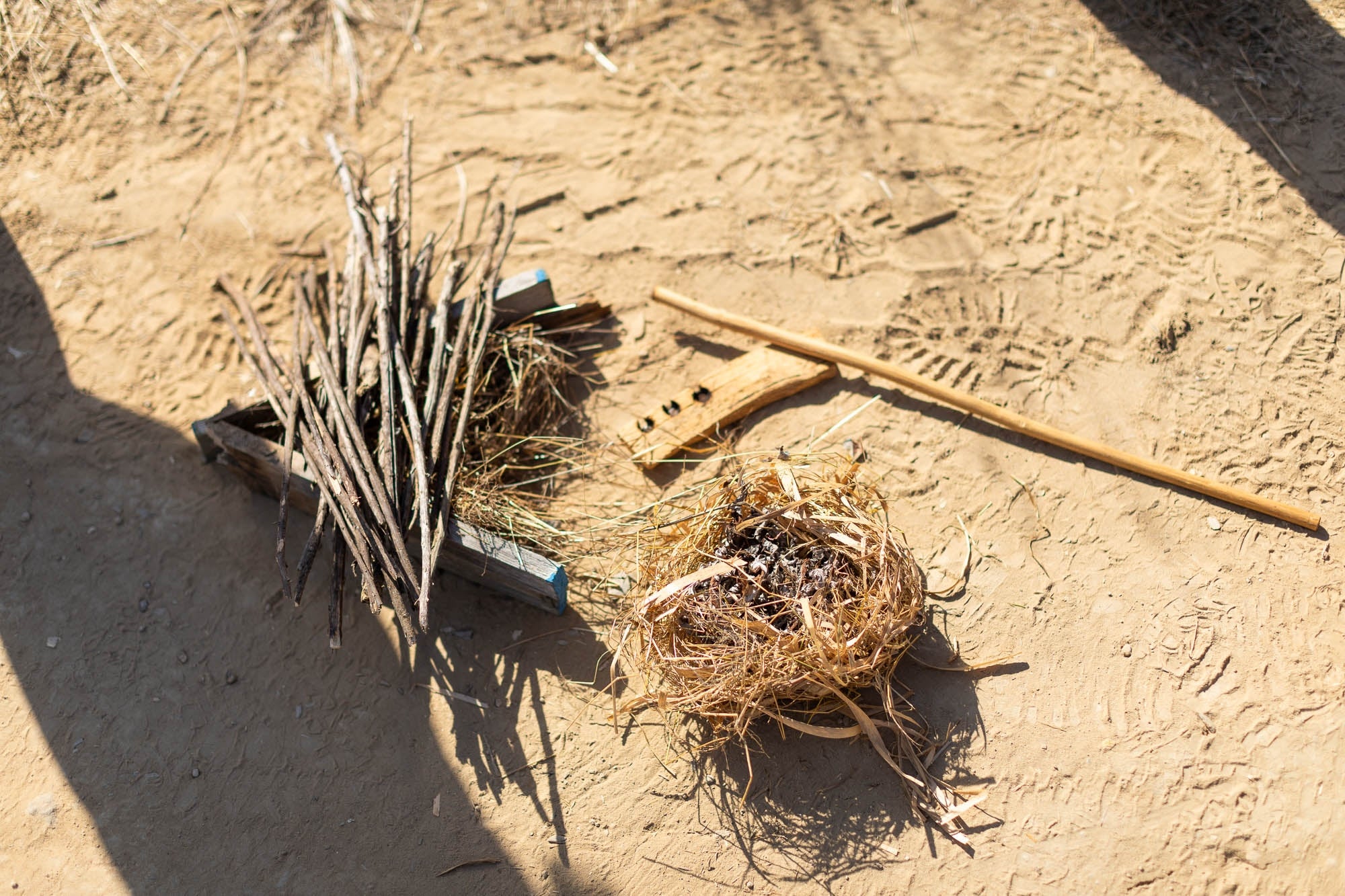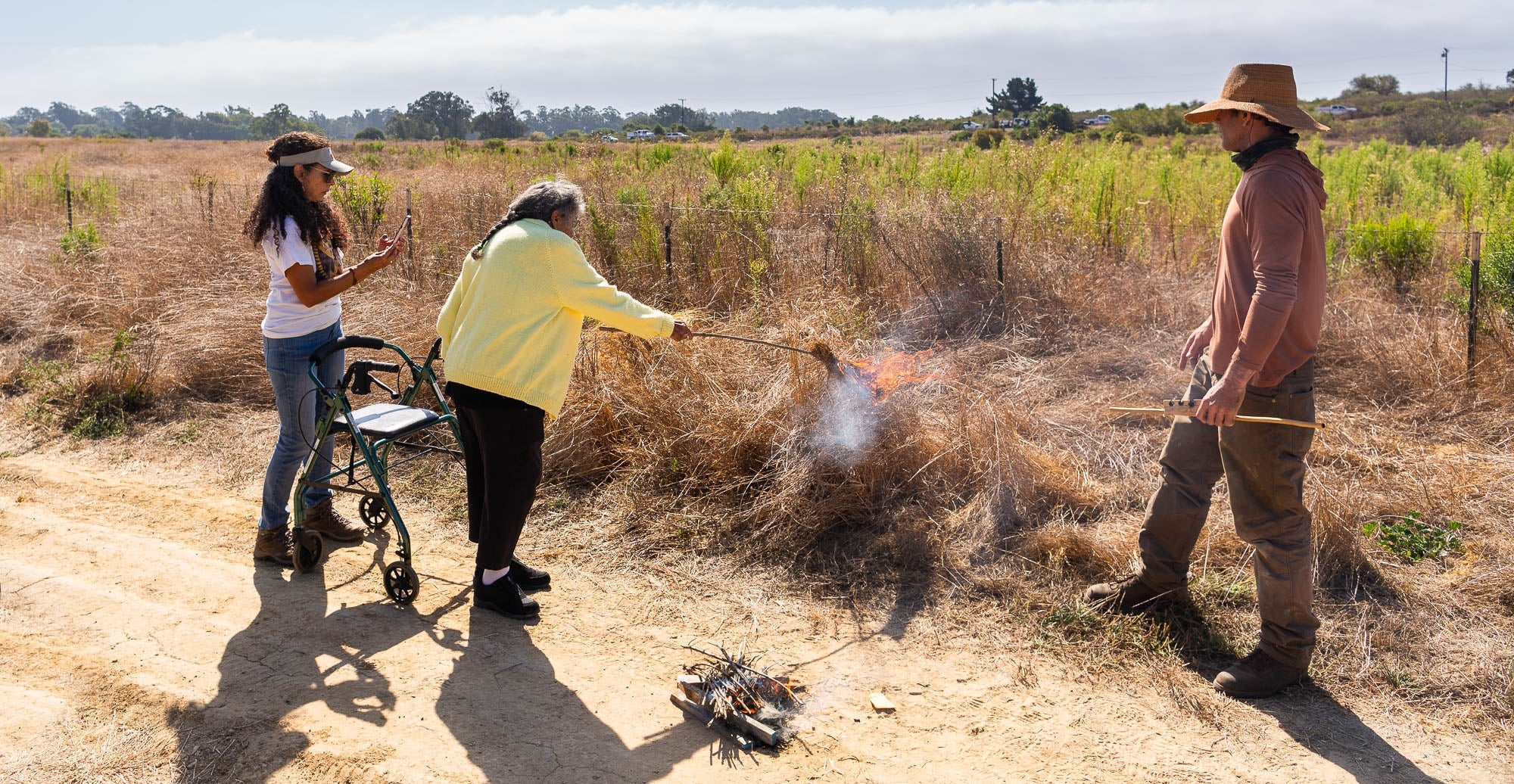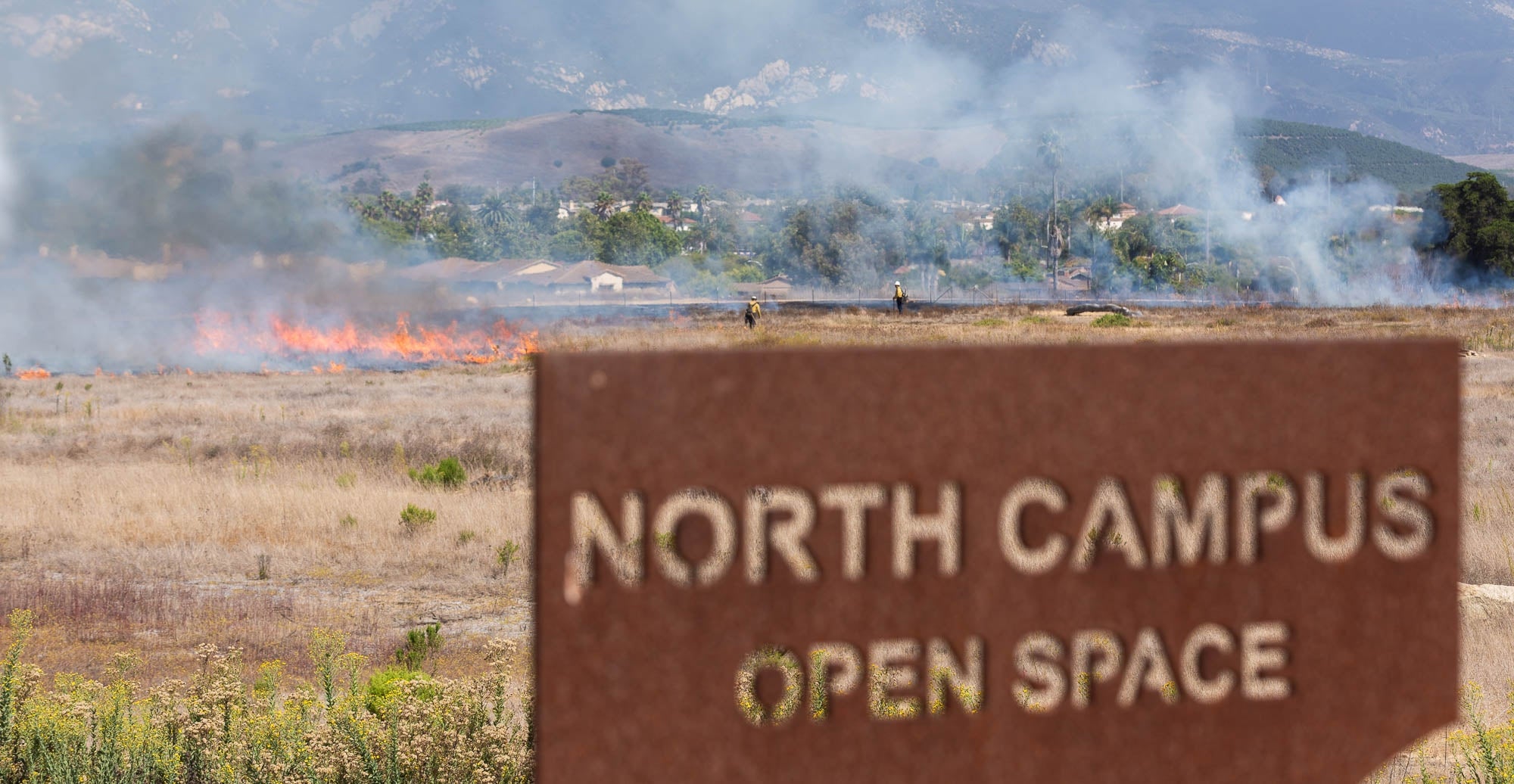Chumash Cultural Burn Reignites Ancient Practice for Wilderness Conservation

By Harrison Tasoff, The Current
Members of the Chumash community gathered at UC Santa Barbara’s North Campus Open Space for an event that none of them had ever witnessed, a practice that had been lost for generations, that most thought would never happen again. More than two centuries since the last cultural burn in the region, they were returning fire to the land in a manner their ancestors may have recognized.
“We’re active in cultural revitalization, language revitalization, and doing this burn is one of those missing puzzle pieces,” said Robyne Redwater, whose family hails from villages in Santa Barbara and the Channel Islands.
Fire was an integral part of Chumash livelihood for centuries, if not millennia. Periodic controlled burns kept the landscape open, promoted the growth of useful plants and facilitated hunting. “A cultural burn is targeted to promote the health of the environment and growth of particular resources like food plants, medicinal plants and basket material,” explained Jan Timbrook, curator emeritus of ethnography at the Santa Barbara Museum of Natural History.
“Here in Southern California, it actually was probably a much more efficient way of producing food than agriculture would have been at the time,” Timbrook said. Today’s familiar crops need water throughout the year, so growing them in Southern California requires irrigation. Even most native crops — think corn, beans and squash — need summer rainfall or irrigation. That requires a high level of centralized authority and labor.
“It was a lot more efficient to just burn these patches periodically, every few years, to increase the growth of these really calorie-dense foods like chia and red maids,” Timbrook explained.
Historical and archeological evidence suggests that this practice was incredibly effective. Although they practiced a hunter-gatherer lifestyle, the Chumash were far from nomadic.
Pre-contact Southern California was likely the most densely populated region north of the Valley of Mexico. The total Chumash population — which extended from Paso Robles to Malibu and inland to the edge of the Central Valley — numbered some 15,000 to 20,000 people.
“Around the Goleta Slough and Mugu Lagoon there were large towns. Some of them had as many as 1,000 people,” Timbrook said. This was a vibrant, bustling society supported by a diversity of resources paired with effective land management.
Now, the Chumash have become a minority in their own homeland. “I frankly thought I was the only Chumash in the world,” said Chumash Elder Ernestine Ygnacio-De Soto, recounting her childhood in the last Chumash-speaking household. Many people with Chumash heritage aren’t part of a federally recognized tribe, don’t have a cultural center and don’t have their own land.
“So it’s important for places like UCSB, the North Campus Open Space, to open these areas for us to do this,” said Marianne Parra, a Chumash woman active in cultural revitalization.
Revitalizing land and culture
In 2009, UC Santa Barbara embarked on a 13-year restoration of the former Ocean Meadows golf course in Goleta. The project transformed the graded grass monoculture back into the vibrant wetland ecosystem it once was, including nearly 20 acres of native California grassland. The North Campus Open Space (NCOS) fully opened to the community in May 2022.
“Integrating prescribed fire in the grasslands was a high priority from the beginning because it could revive a long-practiced tradition, allow us to educate the community and to study how that practice works in the modern context with invasive plants, housing and other constraints,” explained Lisa Stratton, director of ecosystem management at the university’s Cheadle Center for Biodiversity and Ecological Restoration.
Scientists are beginning to realize that Indigenous burning created the patchwork of habitats and ecosystems that fostered greater biodiversity in Southern California. A low-intensity burn can flash through a landscape and open it up to different kinds of plants, many of which are adapted to periodic fires. Indeed, fire agencies, land managers and scientists are increasingly using prescribed burns as an important tool.
But California’s grasslands have changed since colonization. Introduced grasses have taken over, outcompeting the region’s diverse wildflowers with a live-fast-die-young strategy. The dry thatch they leave behind, smothers native herbs and shrubs, and fuels wildfires that race across the landscape.
“Clearly we have problems with fire in California, but if you can pick the time and the place, fire can be a great tool,” said Wayne Chapman, a restoration manager at UCSB’s Cheadle Center. “Especially for grassland management, I think it’s one of the most exciting things we have not yet been able to implement at all, let alone on a regular basis.” For instance, a flush of growth followed the last fire in the San Marcos foothills, including native plants never documented in that area.
Chia sage and red maids (“ ’ilépesh” and “khutash” in in the local kaswa’a language) were among the plants that most benefited from cultural burns. The seeds of these plants — a staple of the traditional Chumash diet — ripen in late spring through early July. Women used seedbeaters to knock the seeds into gathering baskets, in the course of which some seeds were inevitably scattered. After harvesting, they burned the fields to promote the next year’s growth.
Although most knowledge of the technique has been lost to colonization, there are a few things we still know. “They probably used a hand-drill,” explained Chumash Elder Julie Tumamait-Stenslie. “And mugwort was the punk underneath.”
It was then a matter of spinning the drill on the base quickly enough to create an ember. “I’ve tried it once before,” said Tumamait-Stenslie. “It’s not easy.”

Once the tinder caught, the flame was probably transferred to the landscape with a firebrand. Women may have carried the fire from a domestic fireplace if the site was close enough to a village or camp.
And it was definitely women who did this, Timbrook noted, as they were generally the ones gathering food and medicines. “They’re the people who know the most about how these plants grow and the resources that they provide,” she said, “so it seems logical that the women would be handling the management of those kinds of resources.”
“It was up to the older women to do this,” added Parra. These matriarchs were able to draw from years of experience to ensure this dangerous task was carried out safely and successfully.

That’s why the community chose Ernestine Ygnacio-De Soto to lead the fire-lighting ceremony. Ygnacio-De Soto is the daughter of the last native speaker of any Chumash language and traces her ancestry to a long line of local chiefs. The irony is that she’s terrified of fire. “I got my fingers burned playing with matches when I was four or five. So fire is not my favorite,” she said. “Never played with matches again.”
So why did she agree to light the fire? “Because I’m the elder,” she replied. “Because I’m from here. I do descend from the chiefs, and I have to hold that position.”
A broken chain
The Chumash peoples practiced sophisticated land management to sustain themselves. But colonists had a different way of life and a different perspective, so they didn’t recognize the utility of Indigenous burning practices. “Some of the earliest Spanish explorers who came through this area complained in their journals about the fact that they’re having trouble finding pasturage for their horses and livestock because the ‘heathens’ had burned off all the grasslands,” Timbrook said.
The tradition of burning came to an abrupt end on May 31, 1793, when interim Spanish governor José Joaquín de Arrillaga outlawed the practice. In his proclamation, Arrillaga sought to “uproot this very harmful practice of setting fire to pasture lands,” making the practice illegal not just in the vicinity of towns, “but even at the most remote distances.”
“It’s basically been a crime throughout much of California for 230 years now,” said restoration specialist Chapman. “And the first place that it was made a crime was Santa Barbara: posted at the Presidio.”
“One can imagine that there was this horrible moment where these old women walked up to do what they’d been doing in the fall, and some Spanish soldier rode up on a horse and made it clear, in no uncertain terms, that it was not going to happen anymore,” Chapman said.
“Our ancestors that went through the mission system probably assumed that many of these rituals or practices would never happen again,” Parra said. And while cultural burning has been mostly lost to history, that hasn’t stopped Chumash today from trying to rediscover and revitalize what their ancestors did.
Parra herself didn’t fully understand traditional burning growing up, but her grandmother Anne continued the practice in spirit. Each year, Anne Parra would perform a ritual before setting her own garden alight. “I didn’t realize the value of what she was doing every day,” Parra said, recalling how her grandma would wake the children up to participate in various ceremonies and traditions.
“I’m so thankful that I had that upbringing, and that I got to spend so much time with her as a child,” she added. “Those are lessons you can’t purchase.” Parra has used this gift wisely, sharing her knowledge and inspiration with her daughters, Robyne Redwater and Alikoi Parra, who have taken up the baton as well.
Hope, determination and action
Despite what the Chumash lost to colonization — and they lost a lot — cultures are living things, characterized as much by their history as their future. “We always say we’re the past, present and future,” Marianne Parra said.
The Chumash are working hard to gain more agency over their own cultural practices. “Being out here getting first-hand experience, and hopefully being able to carry it to future generations ourselves, is really the ultimate goal,” said Redwater, who is currently learning the kaswa’a Chumash language, as well. “In the future, our hope is to have an all-female, Indigenous fire-keeper team.”
And the term “fire-keeper” is important. “We’re trying to really push away from this dichotomy of good and bad fires,” said Redwater’s sister Alikoi Parra. The same fire can be beneficial and destructive, useful and harmful. “We have to learn how to work with fire.”

“I’m always a great believer in continuity of care,” said Ygnacio-De Soto, who worked as a nurse for 45 years. “So it’s not the start of bringing these practices back that matters as much as what happens after.” For her, that includes future burns, greater Chumash involvement and cultivation of traditional food plants.
According to Stratton, UC Santa Barbara has every intention to continue this relationship. “We’ve been meeting with people from different groups of Chumash, and one of the realizations is that this is just the first step in a much longer process of integrating the Chumash into these traditional land management practices,” Stratton said.
She’d like to see cultural burns expand beyond NCOS. There are a lot of degraded grasslands in coastal California, she explained. This burn could initiate a larger process of learning to use fire to open up the landscape and promote biodiversity in conjunction with Indigenous communities.
“We’re going to have to just relearn it, and help each other,” added Chapman. “It’s not about going back. It’s about going forward with knowledge from the past and lessons from the past to make a better future.














